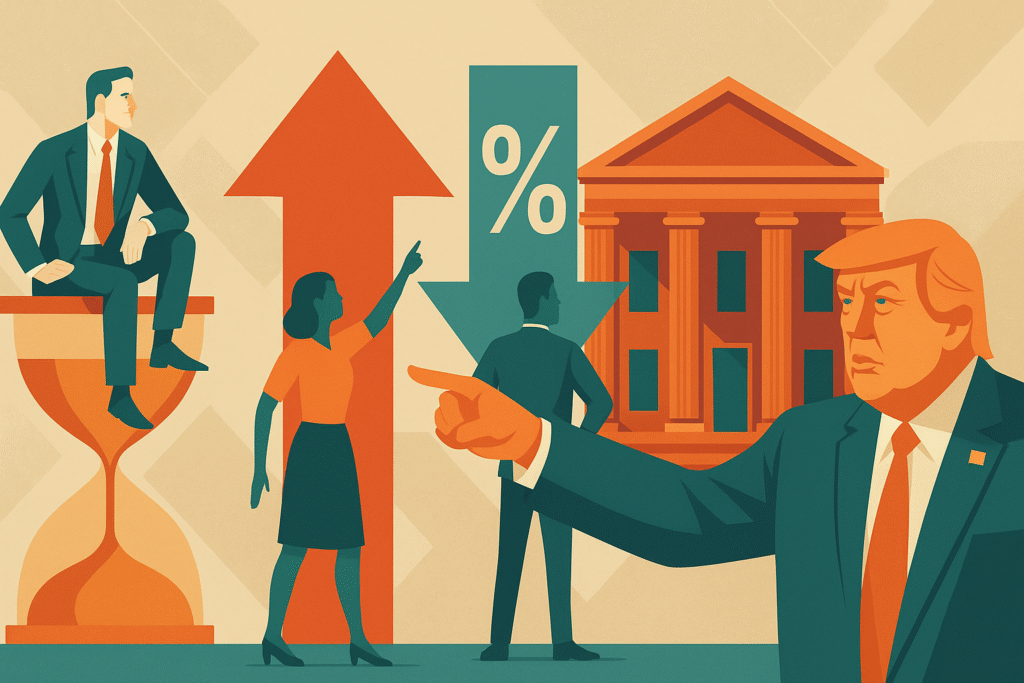As the Federal Reserve concludes its two-day policy meeting this week, analysts widely anticipate that it will maintain current interest rates, opting not to make any immediate changes amid ongoing economic uncertainty and political pressure from President Donald Trump.
Fed Holds Steady, Hints at Caution
The Fed often signals rate changes in advance when confident in the economic outlook. However, this time, officials are likely to remain vague due to lingering concerns over inflation, trade policy effects, and mixed economic signals. President Trump has repeatedly urged the central bank to lower rates, calling on Fed Chair Jerome Powell to act swiftly to support the economy. While Trump met with Powell last week and claimed he would not attempt to remove him, speculation remains high.
Two Republican Fed governors—Christopher Waller and Michelle Bowman—are said to support Trump’s call for an immediate rate cut, which could lead to a rare dual dissent from within the board. According to JPMorgan economist Michael Feroli, it would mark the first such dissent since 1993.
September Cut? Fed Stays Noncommittal
Market futures suggest that investors expect two rate cuts before the end of the year, starting with one in September. However, analysts like those at Morgan Stanley believe the Fed will avoid clear commitments due to uncertainty over Trump’s tariff policies and their economic impact.
“The Fed needs more time to determine how the economy is evolving versus its goals,” Morgan Stanley noted.
Ryan Sweet of Oxford Economics echoed that view, arguing the central bank will want to maintain flexibility until more data becomes available on how tariffs are affecting inflation and consumer prices.
Interest Rates: A Balancing Act
The Fed typically cuts rates to stimulate growth and employment or raises them to control inflation. However, Trump’s escalating tariffs complicate that dynamic, as they risk both slowing the economy and fueling inflation—conflicting challenges for the Fed.
Powell has said the Fed is closely monitoring which risk—slowing growth or accelerating prices—poses the greater threat.
Last year, the Fed cut its benchmark interest rate by 1% as inflation from the pandemic eased. It has held rates steady since.
Trump’s Tariffs Add Pressure
Trump’s tariff policies have added to the complexity. While a 90-day delay in tariffs on Chinese and other imports earlier this year eased short-term market fears, the overall impact remains uncertain.
In recent weeks, Trump struck trade deals with several countries, including the UK, Vietnam, Indonesia, the Philippines, and China, but most include tariffs ranging from 15% to 30%. Trump has also proposed increasing tariffs on Canadian imports to 35%, and on goods from Mexico and the EU to 30%.
Currently, a 50% tariff is in place on metals, 25% on cars, and 30% on Chinese products.
Tariff-Driven Inflation Is Emerging
Until recently, tariffs had a minimal effect on inflation, but June’s consumer data suggest rising prices in several categories, including apparel (+0.4%), furniture (+1%), electronics (+1.1%), and toys (+1.8%).
Core inflation rose slightly from 2.8% to 2.9%. Analysts believe many companies are now passing tariff costs onto consumers after exhausting earlier stockpiles and absorbing price increases.
Morgan Stanley believes these developments may nudge Powell closer to considering rate cuts, but not enough to make a firm commitment just yet.
Economy and Labor Market Sending Mixed Signals
Economic data remains inconclusive. Retail sales rose 0.5% in June, but adjusted for inflation, growth appears weaker. GDP for Q2 is expected to show a 2.2% rebound, largely due to the reversal of a Q1 import surge rather than strong domestic growth.
The job market also shows signs of slowing. The U.S. added 147,000 jobs in June, but only 74,000 came from the private sector, mostly in healthcare. Economists expect only 118,000 new jobs in July, raising concerns about the sustainability of job growth.
Inflation Forecast and Investor Concerns
Economist Kathy Bostjancic predicts the average U.S. tariff rate will rise from 2% to 20% by year-end, pushing inflation to around 3%—above the Fed’s 2% target but below earlier fears of 3.4%.
She also warns that Trump’s attacks on Powell and the Fed’s independence could undermine confidence in its decision-making, leading investors to suspect politically motivated rate cuts. That could in turn push long-term interest rates higher, undercutting Trump’s goal of cheaper borrowing.
Conclusion
While the Fed is expected to maintain current interest rates this week, its next moves remain uncertain. The central bank is caught between the opposing forces of trade-induced inflation and slowing growth, all under the intense spotlight of presidential pressure. Whether a rate cut arrives in September will depend on how those competing risks evolve over the coming weeks.



